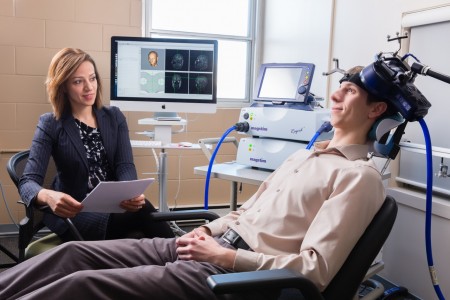Generic Seroquel XR Approved
 Earlier this year, the US Food and Drug Administration approved a generic version of Seroquel XR tablets (Quetiapine Fumarate Extended-Release Tablets), which are used to treat both depression and mania in bipolar disorder, schizophrenia, and to augment the effects of antidepressants in unipolar depression. Also known as quetiapine, the generic tablets will be available in 50 mg, 150 mg, 200 mg, 300 mg, and 400 mg doses.
Earlier this year, the US Food and Drug Administration approved a generic version of Seroquel XR tablets (Quetiapine Fumarate Extended-Release Tablets), which are used to treat both depression and mania in bipolar disorder, schizophrenia, and to augment the effects of antidepressants in unipolar depression. Also known as quetiapine, the generic tablets will be available in 50 mg, 150 mg, 200 mg, 300 mg, and 400 mg doses.
Seroquel XR is taken once per day several hours before bedtime in the acute treatment for bipolar depression (300 mg/day), mania or mixed episodes (300–600 mg/day) or their prevention (400 mg/day); or paired with antidepressants to treat unipolar depression (150–300 mg/day).
The generic tablets, which are expected to be more affordable than Seroquel XR, are produced by Pharmadax Inc.
Study Shows FDA Drug Safety Warning on Citalopram Backfired
In August 2011, the US Food and Drug Administration issued a warning that doses of the selective serotonin reuptake inhibitor (SSRI) antidepressant citalopram (Celexa) that exceeded 40mg/day could prolong the QT interval, a measure of heart rate used to diagnose abnormal heart rhythms. A study of records from the Veterans Health Administration showed that 35,848 veterans whose dose of citalopram was reduced from an average of 64mg/day to under 40mg/day faced increased deaths, hospitalizations for any cause, and hospitalizations for depression specifically after the reductions.
The FDA warning meant to prevent heart problems had the unintended consequence of increasing hospitalizations and deaths among the veterans affected. These findings by Thomas S. Rector and colleagues were published in the American Journal of Psychiatry in 2016.
Editor’s Note: There are some similarities between this case and findings by researchers Andrew Nierenberg and Andrew Stoll, who noticed that patients taking 40mg/day of fluoxetine (Prozac) had better long-term outcomes than those taking 20mg/day, even though those taking 40mg were more ill and more likely to relapse at the start of the study.
Researchers Ellen Frank and David Kupfer found that 90% of unipolar depressed patients relapsed when their antidepressant doses were halved, even though they had been stable for 5 years before the change.
These and the findings from Rector and colleagues lead this editor to believe that reducing the dosage of effective treatments should not be done without reason—that is, in the absence of side effects, or simply to achieve the minimal effective dose. Dose reductions without cause not only may increase the risk of relapse, but may also put the patient at increased risk of developing tolerance to the medication, for example hastening the onset of ‘Prozac poop-out.’
When long-term maintenance drug therapy is going well, it may be best to be conservative and stay the course. Conversely, in the absence of a good long-term response, be as active and creative as possible to achieve mood stabilization.
US Lags Behind Canada in Access to RTMS
At the 2015 meeting of the Transcranial Magnetic Stimulation Society, Linda Carpenter, an American researcher who specializes in repeated transcranial magnetic stimulation (rTMS), a method of treating depression by using a magnetic coil placed near the scalp to stimulate neurons, compared notes with Jeff Daskalakis, a Canadian researcher who also studies rTMS.
Carpenter described the limited approval rTMS enjoys in the US. RTMS has been approved by the Federal Drug Administration for the treatment of unipolar depression under very limited parameters (only at a frequency of 10Hz). RTMS has limited availability in the US, and many healthcare companies do not cover it. Providers face scrutiny of study recruitment practices and recordkeeping by insurers and the Joint Commission (formerly the Joint Commission of Accreditation of Healthcare Organizations), which assesses healthcare quality.
In contrast, Daskalakis and his Canadian colleagues can and do use rTMS to treat a broader range of illnesses including bipolar disorder. In Canada rTMS is used to treat unipolar depression, schizophrenia, post-traumatic stress disorder (PTSD), and obsessive-compulsive disorder (OCD), and clinicians can adjust the parameters to treat adolescents and the elderly.
The situation in the US is unfair. Because rTMS has not been approved for the treatment of bipolar disorder, Carpenter and other clinicians in the US are unable to treat bipolar depression even though a wide range of experts and published studies report that rTMS is as effective (or possibly even more so) for patients with bipolar depression than for those with unipolar depression.
Few treatments are available for bipolar depression. The discrepancy is even sadder when one considers that there are already more than 20 FDA-approved antidepressants that can be used to treat unipolar depression, but only three approved medications for bipolar depression. Bipolar depression is an orphan illness, which lacks a powerful voice advocating for more treatment research about optimal therapeutic strategies. Read more
FDA Warning About Antidepressants Followed by Drop in Use, and Increase in Suicide Attempts
A decade ago the Federal Drug Administration (FDA) released several warnings that children, adolescents (ages 10–17), and young adults (ages 18-29) taking antidepressants were at increased risk for suicidal ideation and behavior. A recent study found that following these warnings, antidepressant use among adolescents, young adults, and adults dropped, and psychotropic drug poisonings (a validated measure of suicide attempts) increased among adolescents and young adults. Numbers of completed suicides did not change for any age group.
The decision to place the warnings on antidepressant packaging was somewhat controversial because it was based on studies that were not necessarily designed to measure suicide risk. The relationship between depression, medication, and suicide is complicated. Medication can improve mood, but patients may seek out medication because of pre-existing suicidal thoughts, and the medication may not reduce these in young people.
The reduction in antidepressant use that occurred after the warnings was accompanied by a drop in depression diagnoses in children and adults. Studies have suggested that the decreases in antidepressant were not accompanied by increases in other treatments, such as psychotherapy or atypical antipsychotics, among young people. Increased monitoring of patients was called for in the FDA’s box warning, but did not take place.
The study of the aftermath of the FDA warnings, published by Christine Y. Lu et al. in a 2014 article in the journal BMJ, used data from 11 insurance networks throughout the US. The researchers used an interrupted time series study design, which is used to show whether a policy causes an abrupt change in the expected slope of study outcomes. Data covered the pre-warning period (first quarter of 2000 to third quarter of 2003), the warning “phase-in” period (last quarter of 2003 to last quarter of 2004) and the post-warning period (first quarter of 2005 to last quarter of 2010). The study cohorts included around 1.1 million adolescents, 1.4 million young adults, and 5 millions adults per quarter.
Among adolescents, the previously upward trend in antidepressant use declined by 31.0% in the second year after the warnings, and psychotropic drug poisonings increased by 21.7% (a figure that was statistically significant for males). Poisonings by any drug increased by 13.9% in the second year after the warnings. After 2008, the downward trend in antidepressant use reversed, indicating that either the initial effects of the warning had worn off or that modifications to the warnings in May 2007, which encouraged patients and doctors to consider the risk of antidepressants alongside the risk of leaving mood disorders untreated, led to increased use.
Among young adults, the upward trend in antidepressant use declined by 24.3% in the second year after the warnings, and psychotropic drug poisonings increased by 33.7%, a statistically significant change for both male and female patients.
Among adults, to whom the warnings were not directed, antidepressant use decreased by 14.5% in the second year after the warnings.
The study by Yu et al. is the first to show that suicide attempts actually increased after the FDA warnings. The authors suggest that the increase in suicide attempts might be a consequence of undertreating mood disorders, since antidepressant use dropped simultaneously. The warnings and related media attention may have led to these unintended consequences, since media reports can sometimes be oversimplified.
Most Online Pharmacies Fake, Says FDA
In late 2012, the Federal Drug Administration announced that 97% of online pharmacies violated state or federal laws and/or safety and practice standards set by the National Association of Boards of Pharmacy. Medications sold by fake pharmacies may be fake, expired, contaminated, not approved by the FDA, or unsafe.
Here are some warning signs that may mean an online pharmacy is fake:
- Allows you to buy medications without a prescription.
- Offers prices that are too good to be true.
- Sends spam emails offering discount prices.
- Is located outside the US.
- Is not licensed in the US
Real pharmacies are licensed by the state where they are located. They should provide a physical address and phone number, where you can reach a pharmacist who can answer your questions.





